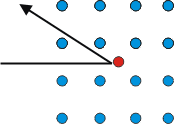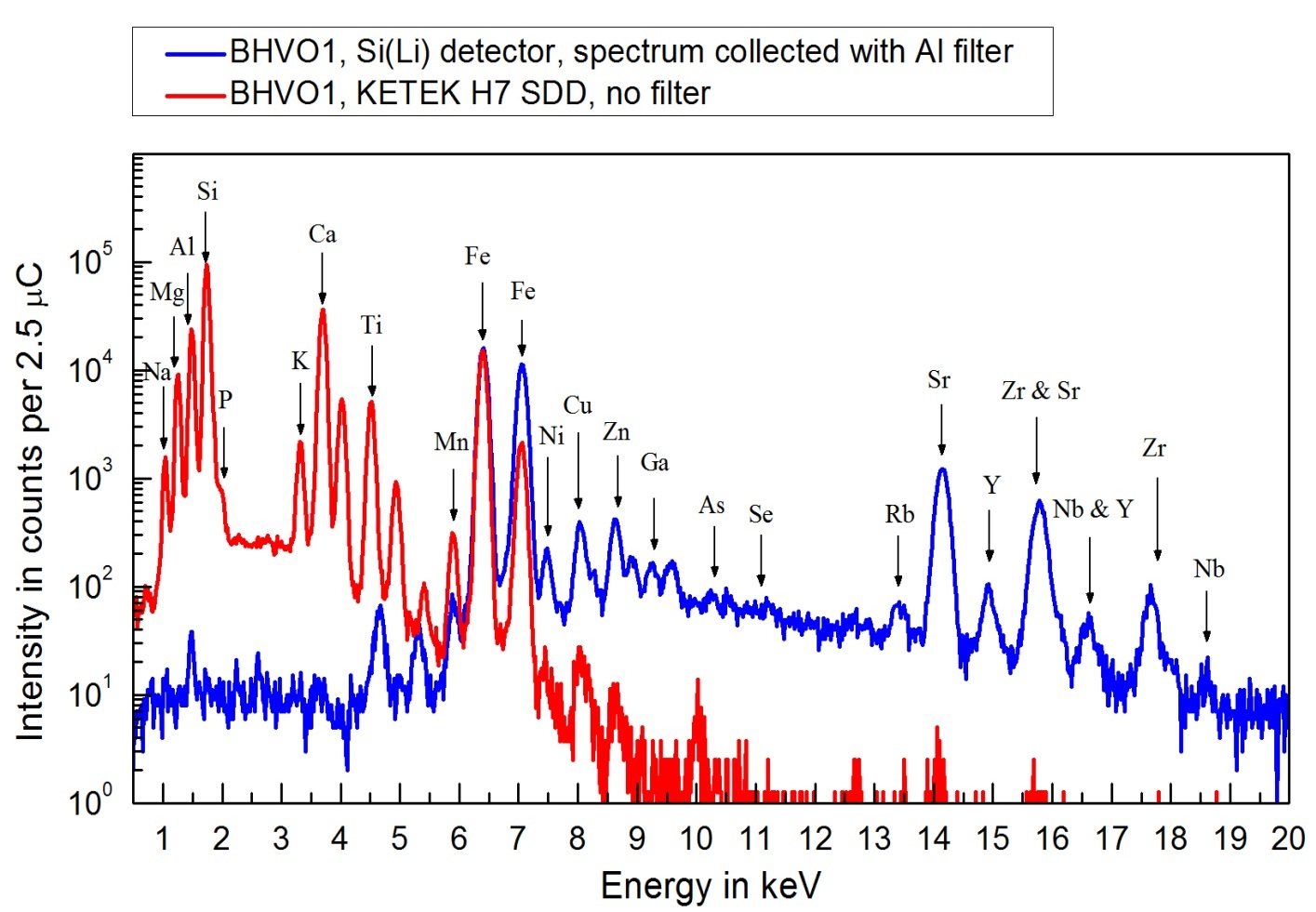Examples of what we can provide
 The best known ion beam analysis technique is Rutherford Backscattering Spetrometry (RBS). A light ions beam (H, He) with energy of 1 - 3 MeV impinges on the target.
The ions backscatter from the near surface region of the sample and are collected by a solid state detector. The energy distribution of the backscattered ions provides
information on both the composition and depth distribution of elements in the target. Thicknesses and composition of the different sample layers are deduced from their energy loss
as they cross the sample. Composition and thicknesses are extracted by comparing experimental spectra to simulations. Ion beam analysis techniques are intrinsically quantitative and
do not require a standard to compare to. In chanelling mode, the alignment of the ion beam with sample crystallographic axes provides crystal defects lattice location.
The best known ion beam analysis technique is Rutherford Backscattering Spetrometry (RBS). A light ions beam (H, He) with energy of 1 - 3 MeV impinges on the target.
The ions backscatter from the near surface region of the sample and are collected by a solid state detector. The energy distribution of the backscattered ions provides
information on both the composition and depth distribution of elements in the target. Thicknesses and composition of the different sample layers are deduced from their energy loss
as they cross the sample. Composition and thicknesses are extracted by comparing experimental spectra to simulations. Ion beam analysis techniques are intrinsically quantitative and
do not require a standard to compare to. In chanelling mode, the alignment of the ion beam with sample crystallographic axes provides crystal defects lattice location.
 The graph on the left shows an RBS measurement and a simulation of Er implanted in a chalcogenide layer deposited on SiO2 (from Fick et al. J. Non Cryst. Sol. 272 (2000) 200.)
Since the different atoms have different masses, the ions are backscattered at different energies. The height of the peaks is proportional to the concentration of that element in the layer,
while the width gives the thickness of the layer. RBS is straightforward, but as it can be seen on the graph, it can be difficult to distinguish close masses, and the signal form light elements (e.g. C, N, O)
is small and pilled on top of the substrate signal. Plus, H is undetectable with this technique. Also, much better depth resolution can be achieved with a special detector and by working at lower energies.
The graph on the left shows an RBS measurement and a simulation of Er implanted in a chalcogenide layer deposited on SiO2 (from Fick et al. J. Non Cryst. Sol. 272 (2000) 200.)
Since the different atoms have different masses, the ions are backscattered at different energies. The height of the peaks is proportional to the concentration of that element in the layer,
while the width gives the thickness of the layer. RBS is straightforward, but as it can be seen on the graph, it can be difficult to distinguish close masses, and the signal form light elements (e.g. C, N, O)
is small and pilled on top of the substrate signal. Plus, H is undetectable with this technique. Also, much better depth resolution can be achieved with a special detector and by working at lower energies.
 In order to solve the sensitivity problem to light elements, and to actually separate the signal from the different target atoms into different spectra, rather than detecting the backscattered ions, we can
detect the other particle involved in the collision: the recoil. That's what is called Elastic Recoil Detection (ERD). However, these events have to be distinguished from the overwhelming contribution from
the scattered beam. In the graph above, the analysis of an oxynitride is achieved by measuring the Time of Flight of the recoils and scattered atoms, hence ERD-TOF. We see that the recoil events from the light
elements are clearly separated from the other signals, and that H is detected. The small amount of N in the oxynitride (between depth 50 and 140) would have been very difficult to detect and simulate by RBS.
Hence, this technique is powerful for quantitative depth profiling of hydrides, carbides, nitrides and oxides, but is also useful in general for the analysis of compounds.
In order to solve the sensitivity problem to light elements, and to actually separate the signal from the different target atoms into different spectra, rather than detecting the backscattered ions, we can
detect the other particle involved in the collision: the recoil. That's what is called Elastic Recoil Detection (ERD). However, these events have to be distinguished from the overwhelming contribution from
the scattered beam. In the graph above, the analysis of an oxynitride is achieved by measuring the Time of Flight of the recoils and scattered atoms, hence ERD-TOF. We see that the recoil events from the light
elements are clearly separated from the other signals, and that H is detected. The small amount of N in the oxynitride (between depth 50 and 140) would have been very difficult to detect and simulate by RBS.
Hence, this technique is powerful for quantitative depth profiling of hydrides, carbides, nitrides and oxides, but is also useful in general for the analysis of compounds.
While distinguishing elements with close masses is achieved easily for light elements by ERD-TOF, this is not the case for heavier elements. This, and finding trace impurities in a quantitative way, can be achieved by particle induced X-ray emission (PIXE), which relies on the X-ray emission by the target atoms in order to identify them. Proton beam currents of a few nA suffice to provide rapid accumulation of spectra in two detector types: SDD for K X-rays of light (Z≥11) major and minor elements; Si(Li) for X-rays of heavier trace elements. In our newer proton microprobe the analysis chamber is being constructed to accomplish both simultaneously. The widely used GUPIXWIN software developed at Guelph fits the spectra and converts X-ray peak areas to element concentrations with a rigorous treatment of matrix effects. In the example shown, for the geochemical reference material BHVO1, the red spectrum is from the major and minor elements and the blue one from the trace elements. Derived concentrations in this case are accurate at the ~ 1 - 2 % level.

Better depth resolution for ultra-thin layers can be obtained by using electrostatic detector and lower energy beam. Medium Energy Ion Scattering (MEIS) is targeted as susch cases. (To be continued.)


